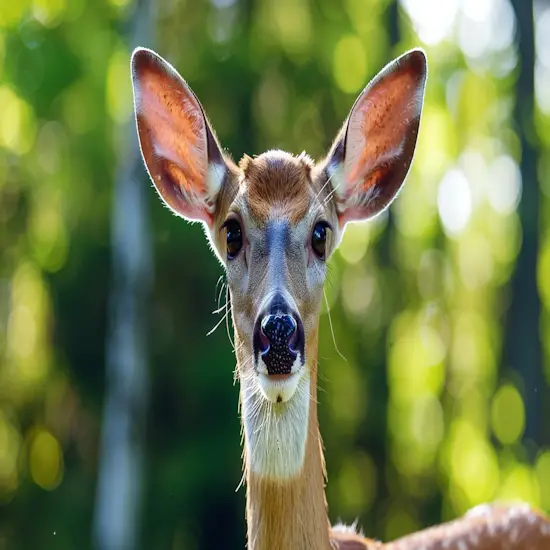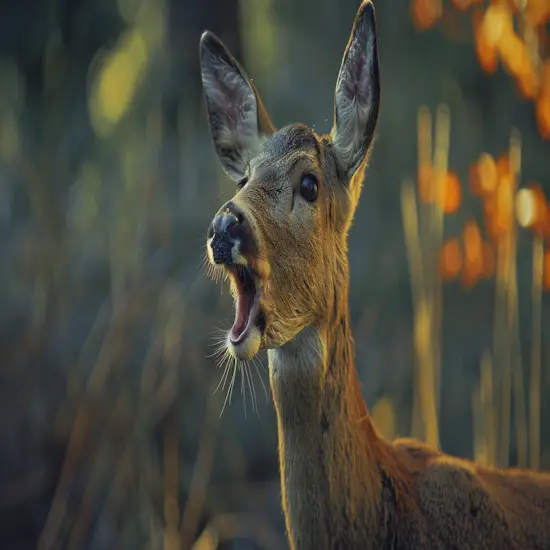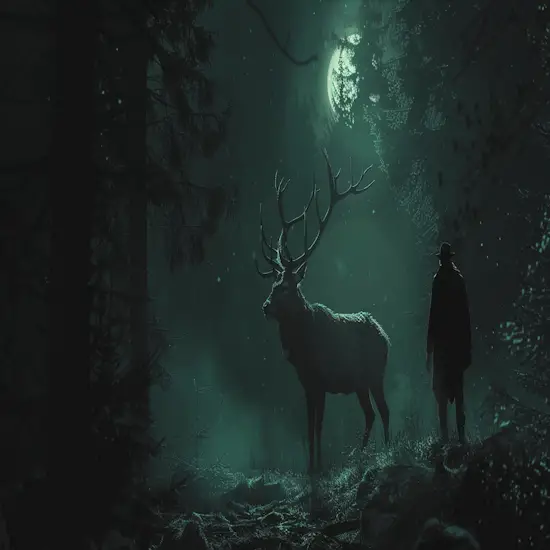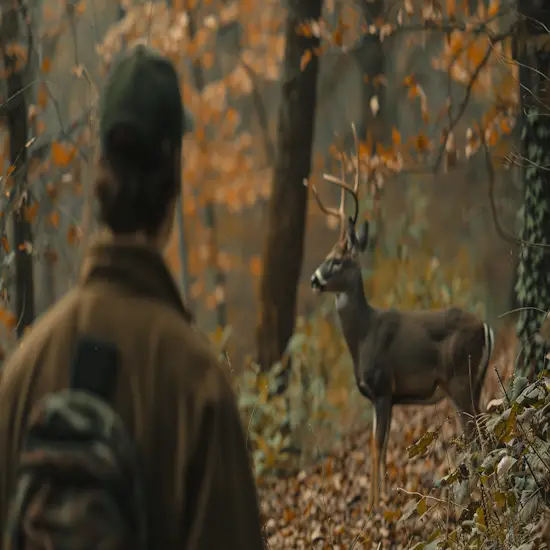Disclosure: We may earn commissions if you purchase products after clicking on a link from our site.
Understanding deer vocalizations and body language allows the deer hunter to plan hunting strategies for a successful hunt. It helps the deer hunter learn about the deer and gain more insight into its behaviors and movements. In this article, we share information to help you learn about deer vocalizations and body language to help you be more successful as a deer hunter.

Table of Contents
Key Takeaways
- Master realistic doe vocalizations for effective communication.
- Pay attention to deer body language cues for better understanding.
- Use vocal inflection to convey emotions and intentions accurately.
- Recognize the significance of different deer sounds in various situations.
- Practice mimicking deer vocalizations and observing body language for proficiency.

Vocalization Techniques
When calling deer, remember to mimic realistic mature doe sounds with proper inflection to attract them. Selecting a quality grunt call, like The Rut Pack 3 from Duel Game Calls, is essential for authentic deer vocalizations. Practice regularly to confirm your calling techniques are authentic and enticing to the deer.
Mimicking Realistic Doe Calls
Mimicking realistic doe calls accurately requires mastering the art of vocalization techniques with precision and attention to detail.
To replicate the sounds of a doe effectively, practice the soft bleats and social calls they use to communicate. Start by listening to recordings of actual doe vocalizations to understand the pitch and rhythm.
Use your voice to mimic the gentle sounds, ensuring you match the tone and cadence. Visualize a doe in your mind to guide your vocalizations, aiming for a natural and realistic portrayal.
Regular practice will help you refine your doe calls, increasing your chances of attracting deer during hunting expeditions. Remember, authenticity is key in drawing deer closer to your location.
Importance of Proper Inflection
To effectively attract deer during hunting expeditions, mastering proper inflection in your vocalization techniques is essential. The way you modulate your calls can make all the difference in drawing deer closer to your position.
By adding the right emphasis and tone to your vocalizations, you can convey emotions and intentions that resonate with deer in the wild. Using varied inflection, such as making your calls sound more urgent or soothing, can help you communicate effectively with different deer behaviors.
Quality Grunt Call Selection
Selecting a quality grunt call is essential for realistic deer vocalizations during hunting expeditions. To make the most out of your hunting experience, consider the following when choosing a grunt call:
- Look for a call with adjustable soundboards for versatile sounds.
- Opt for a call covered in camouflage to blend in seamlessly.
- Choose a call from a reputable brand known for producing realistic deer sounds.
Make sure to invest in a quality grunt call like The Rut Pack 3 from Duel Game Calls to enhance your deer calling techniques and attract deer effectively.
Practice for Authenticity
For authentic deer vocalization techniques, practice consistently to enhance your calling skills and attract deer effectively. Mimic various deer sounds like yelps, grunts, and bleats to achieve realism in your calling. Start by listening to recordings to grasp the nuances of each vocalization. Use grunt calls like The Rut Pack 3 for lifelike sounds.
Focus on proper inflection and timing to make your calls more convincing. Visualize deer in different scenarios to improve your ability to mimic their communication. Practice regularly, using little air on calls to sound natural.

Rut-Related Calling
When engaging in rut-related calling, remember the importance of realism in your grunt calls and mimicry of doe sounds to attract deer effectively.
Understanding the significance of tending grunts in buck communication can enhance your hunting success during this period.
Grunt Call Realism
Achieving realism in deer calling, especially during the rut, is essential for attracting deer and increasing your hunting success. When it comes to grunt call realism, here are some tips to enhance your hunting experience:
- Mimic actual sounds with proper inflection for realistic calls.
- Invest in quality grunt calls like The Rut Pack 3 from Duel Game Calls.
- Practice regularly to perfect your deer calling techniques.
Tending Grunt Importance
Why is understanding the importance of tending grunts crucial during the rut for successful deer calling? Tending grunts play a critical role in the rut, indicating a buck’s focus on a doe. By mimicking these grunts accurately, you can attract bucks searching for receptive does.
Tending grunts communicate a buck’s intention to stay close to a doe in estrus, making them effective in drawing deer closer for potential shots. Learning to recognize and replicate these sounds can greatly enhance your deer calling success during the rut.
Utilizing quality grunt calls like The Rut Pack 3 ensures realistic tending grunts that can entice bucks to come within range, increasing your chances of a successful hunt.
Mimicking Doe Sounds
To effectively mimic doe sounds during rut-related calling, focus on replicating yelps, grunts, and bleats to attract deer. When trying to mimic doe sounds, consider the following tips:
- Vary the pitch and tone of your calls to mimic the natural variability in doe vocalizations.
- Use pauses between calls to imitate the natural cadence of deer communication.
- Incorporate body language movements like mimicking feeding or grooming behaviors to enhance the realism of your calls.
Doe and Buck Communication
During the rut, bucks communicate with does using trailing and tending grunts to establish their presence and intentions. Trailing grunts are used by bucks to locate does, while tending grunts signify the buck’s interest in a particular doe. These vocalizations help maintain contact and coordinate mating activities. Bucks may also emit aggressive grunts to assert dominance or respond to potential threats.
Understanding these rut-related calls can guide your hunting strategies, as mimicking these sounds accurately can attract deer for better hunting opportunities. Quality grunt calls like The Rut Pack 3 are essential for realistic communication. By recognizing and utilizing these vocalizations effectively, you can enhance your chances of success during the deer rut.

Realistic Sound Production
To attract deer effectively, it’s essential to mimic actual deer sounds with proper inflection. Achieving realism in your calling can be done by using a quality grunt call, such as The Rut Pack 3 from Duel Game Calls. Ensuring your calls sound authentic is key to drawing in deer during hunting expeditions.
Mimicking Actual Deer Sounds
Mimicking actual deer sounds accurately is crucial for creating realistic calls and attracting deer effectively. To achieve this, consider the following tips:
- Choose the Right Call: Select a high-quality deer call that can produce a variety of sounds for different situations.
- Practice Regularly: Spend time practicing to perfect your technique and make certain that your calls sound authentic.
- Listen to Deer Sounds: Familiarize yourself with the various vocalizations deer make by listening to recordings or observing them in the wild.
Inflection for Realism
Making your deer calls sound realistic hinges on inflecting them with precision and accuracy to mimic the actual sounds of deer. To achieve this, focus on mastering the nuances of deer vocalizations. Pay attention to the variations in pitch, tone, and duration when practicing your calls.
By adding subtle changes in inflection, you can create a more authentic and convincing deer sound. Practice different scenarios, such as distress calls or mating calls, to enhance your inflection skills. Remember, realistic sound production is key to attracting deer effectively. Keep refining your inflection technique to increase your chances of success in the field.
Quality Grunt Call
For realistic deer vocalizations that attract deer effectively, utilizing a quality grunt call is crucial. When selecting a quality grunt call, consider the following:
- Sound Realism: Make sure the call produces authentic deer sounds to increase its effectiveness.
- Adjustable Features: Seek grunt calls with adjustable settings to mimic various deer vocalizations accurately.
- Durability: Opt for a grunt call made from high-quality materials for longevity and reliability in the field.

Quality Grunt Calls
When choosing a quality grunt call for deer hunting, consider features like adjustable soundboards and camouflage patterns. Remember that inflection plays an important role in producing realistic deer sounds. Focus on achieving realism in your calls to attract deer successfully.
Grunt Call Features
Understanding the key features of quality grunt calls is essential for realistic deer vocalizations during hunting. When choosing grunt calls, look for these important features:
- Adjustable Tone: Quality grunt calls allow you to adjust the tone to mimic different deer sizes and ages accurately.
- Durable Construction: Look for grunt calls made from sturdy materials that can withstand the rigors of hunting in various conditions.
- Natural Sound Reproduction: Opt for grunt calls that produce lifelike deer sounds to enhance your chances of attracting deer effectively.
Selecting a grunt call with these features will greatly enhance your hunting experience by increasing your chances of luring in deer successfully.
Call Inflection Importance
To enhance your deer hunting experience, consider the importance of inflection in using quality grunt calls. When utilizing quality grunt calls like The Rut Pack 3 from Duel Game Calls, remember that the way you manipulate the pitch, tone, and volume can make a significant difference in attracting deer.
Deer are sensitive to the nuances of sound, and by mastering call inflection, you can create more realistic and compelling vocalizations that mimic natural deer communication. Practice varying your inflection to produce different deer sounds accurately.
Quality grunt calls are designed to help you achieve this realism, making them essential tools for any hunter looking to improve their calling technique and increase their chances of a successful hunt.
Realistic Sound Production
Consider mastering the art of call inflection to produce realistic deer sounds with quality grunt calls like The Rut Pack 3 from Duel Game Calls.
To enhance your hunting experience with quality grunt calls, focus on these key points:
- Varying tones and pitch to mimic deer communication accurately.
- Practicing different grunt sequences to imitate natural deer behavior.
- Adjusting the intensity of your calls to match the mood and distance of your target.

Additional Deer Sounds
When out in the field, it’s vital to be aware of additional deer sounds beyond the basics. Understanding aggressive grunt variations, the importance of estrus bleats, and the significance of fawn bleats can enhance your hunting experience.
These sounds offer valuable insights into deer communication and behavior that can improve your hunting success.
Aggressive Grunt Variations
Aggressive grunts among deer vocalizations serve as crucial signals during rutting season. These variations in grunts convey specific messages related to dominance, aggression, and mating readiness.
Understanding these aggressive grunt variations can greatly enhance your hunting experience. Here are some key points to grasp:
- Aggressive grunts typically indicate dominance or challenge within the deer hierarchy.
- The intensity and duration of these grunts can reveal the emotional state of the deer.
- Recognizing the context in which aggressive grunts are used helps in predicting deer behavior accurately.
Estrus Bleat Importance
The estrus bleat is a significant vocalization among deer sounds, particularly during mating seasons. This sound is pivotal for attracting bucks when does are in estrus, signaling readiness to mate. Bucks are drawn to this call, making it an essential tool for hunters looking to lure in potential targets during the rut.
The estrus bleat is distinct from other vocalizations and carries a specific tone that signifies a doe in heat. By replicating this sound accurately using quality calls like The Rut Pack 3 from Duel Game Calls, hunters can increase their chances of attracting bucks in search of a mate. Understanding the importance of the estrus bleat can greatly enhance your deer hunting success during the mating season.
Fawn Bleat Significance
Understanding the significance of the fawn bleat among additional deer sounds is essential for enhancing your hunting skills and success. Fawn bleats serve as crucial communication tools in the deer world, conveying specific messages that can aid hunters in their pursuits. Here are some key points to keep in mind:
- Fawn bleats are high-pitched vocalizations used by young deer to communicate distress, seeking attention, or signaling their location.
- The fawn bleat can attract does looking for their young, providing hunters with an opportunity to lure in adult deer.
- Mimicking the fawn bleat can be an effective strategy during the early hunting season when fawns are still dependent on their mothers.

Tips for Effective Calling
When calling deer, remember to mimic realistic sounds with proper inflection for maximum effectiveness. Utilize quality grunt calls like The Rut Pack 3 from Duel Game Calls to attract deer successfully. Regular practice is key to honing your calling skills and increasing your chances of a successful hunt.
Mimicking Realistic Deer Sounds
To effectively mimic realistic deer sounds when calling, focus on mastering the proper inflection and cadence of the calls. Here are some tips to help you enhance your deer calling skills:
- Listen to Real Deer Sounds: Immerse yourself in recordings of actual deer vocalizations to understand the nuances.
- Practice Regularly: Dedicate time to practice your calls with attention to detail on the inflection and timing.
- Visualize Deer Behavior: Envision how deer move and react in different situations to bring authenticity to your calling.
Importance of Inflection
For effective deer calling, mastering the nuances of inflection in your vocalizations is essential. Inflection refers to the rise and fall of pitch, which adds depth and realism to your calls.
When mimicking deer sounds, pay attention to the way tones shift within a call. For example, a trailing grunt may start with a low pitch and rise slightly towards the end. This variation in pitch can convey different emotions or intentions to deer.
Experiment with different inflections to match the mood you want to portray, whether it’s a soothing bleat to attract does or an aggressive grunt to challenge bucks. Remember, the right inflection can make your calls sound more authentic and increase your chances of luring deer closer.
Utilizing Quality Grunt Calls
Mastering the nuances of inflection in your vocalizations is fundamental for effective deer calling. To enhance this skill, utilizing quality grunt calls is key for attracting deer with realistic sounds.
When using grunt calls, remember:
- Maintain a consistent rhythm and cadence to mimic natural deer communication.
- Vary the intensity and duration of your grunts to create a more authentic calling sequence.
- Practice different grunt tones to imitate various deer personalities and situations accurately.
Regular Practice for Effectiveness
Regularly practicing your deer calling techniques is essential for improving your effectiveness in attracting deer with realistic sounds. By dedicating time to honing your skills, you can fine-tune your ability to mimic authentic deer vocalizations and increase your chances of luring deer closer.
Start by listening to recordings of deer sounds to familiarize yourself with the nuances of each call. Use controlled air pressure when using grunt calls to produce accurate tones. Visualize deer in your surroundings as you practice to enhance your realism.
Consistent practice will build your confidence and help you master the art of deer calling, making you a more successful hunter in the field. Remember, practice makes perfect when it comes to attracting deer with your calls.

Deer Calling Gear
When it comes to deer calling gear, you’ll want to think about equipment like adjustable soundboards for various sounds and camouflage options for blending in seamlessly.
Gear such as the Double Back Grunt Call and Micro Heat Bleat Call can enhance your hunting experience by providing essential features for attracting deer.
Make sure you have the necessary equipment for night hunting as well, as sound control and visibility gear are vital for success in the field.
Gear for Deer Calling
For effective deer calling, having the right gear is essential. When you’re out in the field, make sure you have the following gear to enhance your deer calling experience:
- Double Back Grunt Call: This call offers an adjustable soundboard for various sounds, allowing you to customize your calling techniques.
- Micro Heat Bleat Call: Another essential in your gear collection, this call also features an adjustable soundboard for realistic bleats and calls.
- Mossy Oak Break-Up Country Camouflage: Guarantee your gear blends seamlessly with the environment, increasing your chances of staying hidden from keen deer eyes.
Having the right gear can make a significant difference in the success of your deer calling efforts.
Camouflage Options Available
To maximize your concealment and increase your chances of staying hidden from deer, consider the Mossy Oak Break-Up Country Camouflage as part of your deer calling gear ensemble.
This camouflage pattern blends seamlessly with various hunting environments, providing you with effective cover while you use your deer calls. The Mossy Oak Break-Up Country Camouflage is designed to break up your outline and help you blend into the natural surroundings, making it harder for deer to spot you.
Adjustable Soundboard Features
Consider incorporating adjustable soundboard features into your deer calling gear ensemble for enhanced versatility in producing various deer sounds. These features can greatly improve your hunting experience by allowing you to adapt your calls to different situations more effectively.
Here are three benefits of utilizing adjustable soundboard features:
- Customizable Sound Range: Adjust the soundboard to mimic different deer vocalizations accurately.
- Enhanced Realism: Fine-tune your calls to sound more natural and attract deer with increased authenticity.
- Adaptability: Easily switch between different types of calls without needing multiple devices, making your gear more efficient and convenient for hunting trips.
Essential Night Hunting Equipment
Utilize essential night hunting equipment for deer calling gear to enhance your success in low-light hunting conditions. When it comes to night hunting, having the right gear is essential.
Opt for quality grunt calls like The Rut Pack 3 from Duel Game Calls for realistic deer sounds. The Double Back Grunt Call and Micro Heat Bleat Call with adjustable soundboards are ideal choices. These calls, covered in Mossy Oak Break-Up Country camouflage, offer versatility in producing different deer sounds.
Additionally, trending gear like the Tibbee Flex Hunt 1/4 Zip, Hunt Pant, Long Sleeve Hunt Tee, Neck Gaiter, and Mesh Mask can provide the comfort and functionality needed for a successful night hunt.

Night Hunting Insights
When night hunting, make sure you have essential gear for visibility and sound control. Remember to prioritize safety by handling firearms properly and staying aware of your surroundings. To succeed in the dark, scout your location, set up strategically, and utilize technology for an advantage.
Night Hunting Gear Essentials
Understanding the essential equipment for night hunting is crucial for maximizing your success in low-light conditions. Here are three important night hunting gear essentials to take into account:
- Night Vision Optics: Equip yourself with high-quality night vision goggles or scopes to enhance visibility in the dark.
- Tactical Flashlight: A reliable, durable flashlight with adjustable brightness levels is vital for moving through the terrain and spotting game.
- Camouflage Gear: Opt for camouflage clothing and accessories designed for night hunting to blend seamlessly into the surroundings and remain undetected by your prey.
These gear essentials won’t only improve your visibility and safety during night hunts but also increase your chances of a successful outing.
Sound Control Importance
Enhance your night hunting success by prioritizing control over sound levels in the dark environment. When hunting at night, excess noise can startle deer and make them wary. To minimize sound, move slowly and deliberately, avoiding stepping on dry leaves or twigs. Use gear with noise-dampening features like padded straps and quiet zippers.
Exercise caution when handling equipment to prevent accidental clangs or rustling. Remember, in the silence of the night, even small sounds can carry far and alert nearby deer. By mastering sound control techniques, you increase your chances of remaining undetected and getting closer to your target without spooking them. Keep sound discipline in mind for a more successful night hunting experience.
Safety Precautions for Night
Prioritize your safety during night hunting by implementing essential precautions to guarantee a successful and secure experience. When venturing out for night hunting, make sure you follow these vital safety measures:
- Use Proper Lighting:
- Carry a reliable and powerful flashlight to illuminate your surroundings.
- Utilize red or green lens covers to maintain your night vision.
- Avoid shining lights directly at deer to prevent spooking them.
- Maintain Firearm Safety:
- Always treat your firearm as if it’s loaded.
- Keep your finger off the trigger until you’re ready to shoot.
- Be aware of your target and what lies beyond it before firing.
- Stay Aware of Your Surroundings:
- Constantly scan the area for other hunters.
- Be mindful of your footing to avoid tripping or falling.
- Trust your instincts and retreat if you feel unsafe.

Turkey Hunting Tactics
When turkey hunting, grasping the significance of calling techniques, strategic decoy placement, and the use of camouflage for concealment are key elements for a successful hunt.
Utilize different turkey calls effectively to attract your target, guarantee your decoys are strategically positioned to draw in turkeys and blend into your surroundings with proper camouflage.
Calling Techniques Importance
Understanding the importance of calling techniques in turkey hunting tactics is essential for maximizing your success in the field. When it comes to calling techniques, remember these key points:
- Variety is Key: Utilize a range of turkey calls such as yelps, clucks, and purrs to attract different birds.
- Practice Makes Perfect: Regularly practice your calling techniques to improve your skills and sound more natural.
- Be Patient: Don’t overcall; sometimes, a few well-timed calls are more effective than continuous calling.
Effective Decoy Placement
For successful turkey hunting tactics, make sure your decoys are strategically positioned to attract birds effectively. Place your decoys within 20-25 yards of your hunting spot, facing you for a clear shot opportunity. Position them in open areas where turkeys can easily spot them.
Consider using a mix of hen and tom decoys to simulate a realistic scene and draw in both male and female turkeys. Confirm that your decoys are visible from a distance and set them up in a way that allows approaching turkeys to see them.
Camouflage for Concealment
To enhance your success in turkey hunting tactics, consider the importance of utilizing effective camouflage for best concealment in the field. Turkey hunting requires blending seamlessly with the surroundings to avoid detection. Here are key points to optimize your camouflage strategy:
- Choose camouflage that matches the environment to break your outline.
- Use face masks and gloves to conceal exposed skin.
- Stay still and blend in with the natural surroundings to avoid spooking turkeys.

Deer Hunting Strategies
When hunting deer, paying attention to body language signals, recognizing key signs, understanding rub patterns, and tracking deer movements are essential strategies.
Observing relaxed behaviors, detecting warning signs, and interpreting suspicious actions can guide your hunting decisions effectively. Enhancing your skills in reading body language and tracking deer signs will greatly improve your hunting success.
Body Language Interpretation Tips
How can you effectively interpret deer body language to enhance your hunting strategies? Understanding deer body language is vital for successful hunting. Here are some tips to help you interpret their signals effectively:
- Observe Tail Movements: Pay attention to how the deer’s tail behaves, as it can indicate their alertness level.
- Monitor Ear Positions: Deer ears can give you valuable insights into their awareness and potential danger nearby.
- Recognize Hoof Stamps: Hoof stamping is a warning sign that signifies suspicion or threat detection, prompting other deer to be cautious.
Sign Recognition Importance
Recognizing deer signs is essential for refining your hunting strategies and increasing your chances of success. Understanding signs of aggression, relaxation, or alertness in deer is vital. By differentiating between doe and buck reactions and interpreting posturing cues like neck positioning and ear movements, you can determine the best course of action while hunting.
Knowing when to act or remain still based on deer body language enhances your hunting success. Accurate interpretation of deer signs provides valuable insights that can greatly improve your hunting opportunities. Paying attention to these subtle cues and responding accordingly can make a notable difference in your deer hunting outcomes.
Rubs and Behavior Analysis
Understanding deer behavior through analyzing rubs is essential for enhancing your hunting strategies and success in the field. By examining rubs and rublines, you can gain valuable insights into deer activity and territorial behavior. Here are some key points to take into account:
- Large-diameter tree rubs offer clues about deer movement patterns.
- Debunk myths surrounding rubs like velvet shedding or aggression.
- Locating rubs and rublines can help you pinpoint high-traffic areas for hunting.
Reading rubs is a valuable skill that can aid you in interpreting deer behavior accurately. Use this knowledge to your advantage when planning your hunting strategies to increase your chances of a successful hunt.
Tracking Deer Signs
Shifting from analyzing rubs to comprehending deer behavior, tracking deer signs through their tracks provides valuable insights for successful hunting strategies. Monitoring track direction on trails can reveal the time of day deer are active.
Differentiating track sizes helps identify family group trails versus mature buck trails. Observing tracking patterns around food sources reveals deer movement timings. Paying attention to these details enhances understanding of deer movements for more effective hunting.
The Bottom Line
Understanding deer vocalizations and body language helps the deer hunter plan his strategies. It allows the hunter to better understand deer behaviors and movements.
In this article, we discussed understanding deer vocalizations and body language to give the hunter the knowledge needed to better plan to hunt deer.
You can also read about other deer hunting methods like spot and stalk hunting for deer, deer drives for deer hunting, still hunting for deer, and ambush hunting for deer.
